Abstract
We used soluble, C-fixing antibody/dsDNA IC to investigate immune complex (IC) handling and erythrocyte (E)-to-phagocyte transfer in chimpanzees. IC bound efficiently to chimpanzee E in vitro and showed minimal release with further in vitro incubation in the presence of serum in EDTA (less than or equal to 15% within 1 h). These IC also bound rapidly to E in vivo (70-80% binding within 1 min) and did not show detectable release from E in the peripheral circulation after infusion in vivo (less than or equal to 2% within 1 h). Despite such slow C-mediated release of IC from E, IC were rapidly stripped from E by the mononuclear phagocyte system (T50 for E-IC1500 = 5 min) without sequestration of E. Treatment of the chimpanzees with the anti-Fc gamma RIII MAb 3G8 impaired the clearance of infused IC. This effect was most evident on the fraction of IC500 which did not bind to E and which presumably had captured less C3b (pre-MAb 3G8 T50: 45 min vs. post-MAb 3G8 T50: 180 min). With IC bound in vitro to E before infusion, anti-Fc gamma RIII MAb treatment led to significant amounts of non-E bound IC detectable in the circulation. Thus, the anti-Fc gamma RIII MAb appeared to interfere with the ability of fixed tissue mononuclear phagocytes to take up/or retain IC after their release from E. Both rapid stripping of IC from E, despite slow complement-mediated release of IC from E in the peripheral circulation, and blockade of IC clearance with anti-Fc gamma RIII MAb indicate that the interaction of IC with the fixed tissue phagocyte involves qualitatively different mechanisms than the interaction of IC with E. Fc gamma receptors appear to play an important role in the transfer and retention of IC by the phagocyte.
Full text
PDF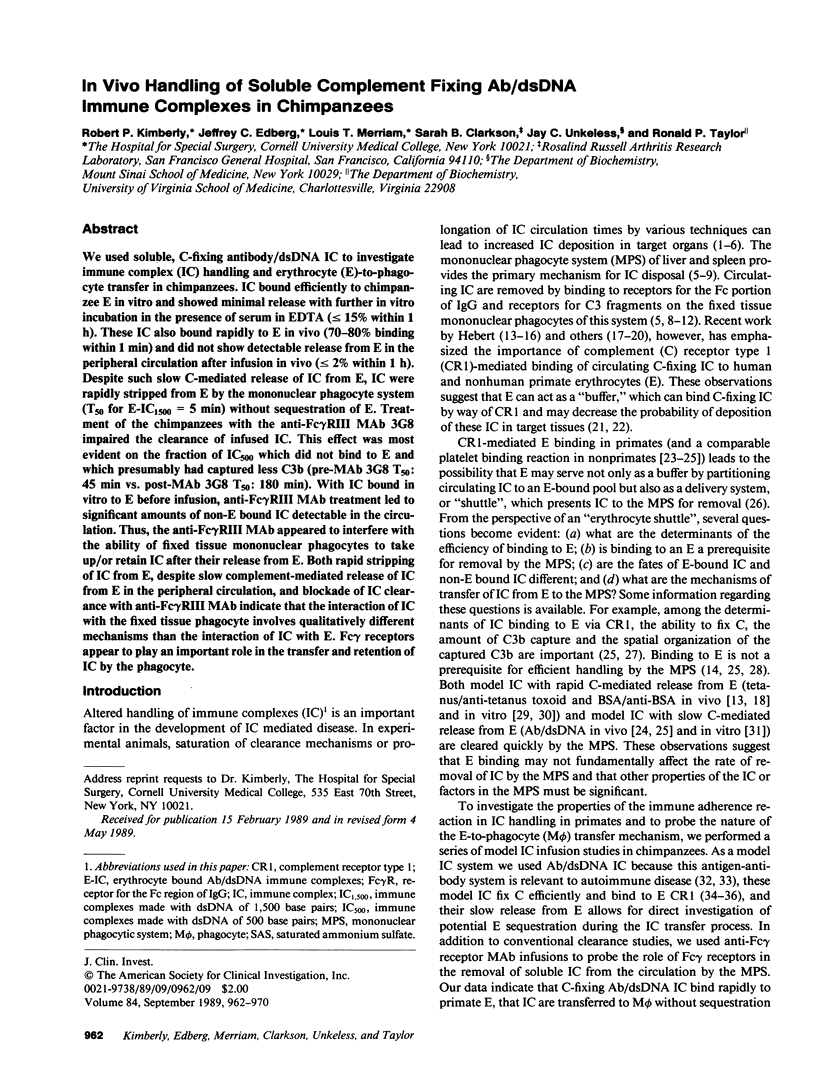
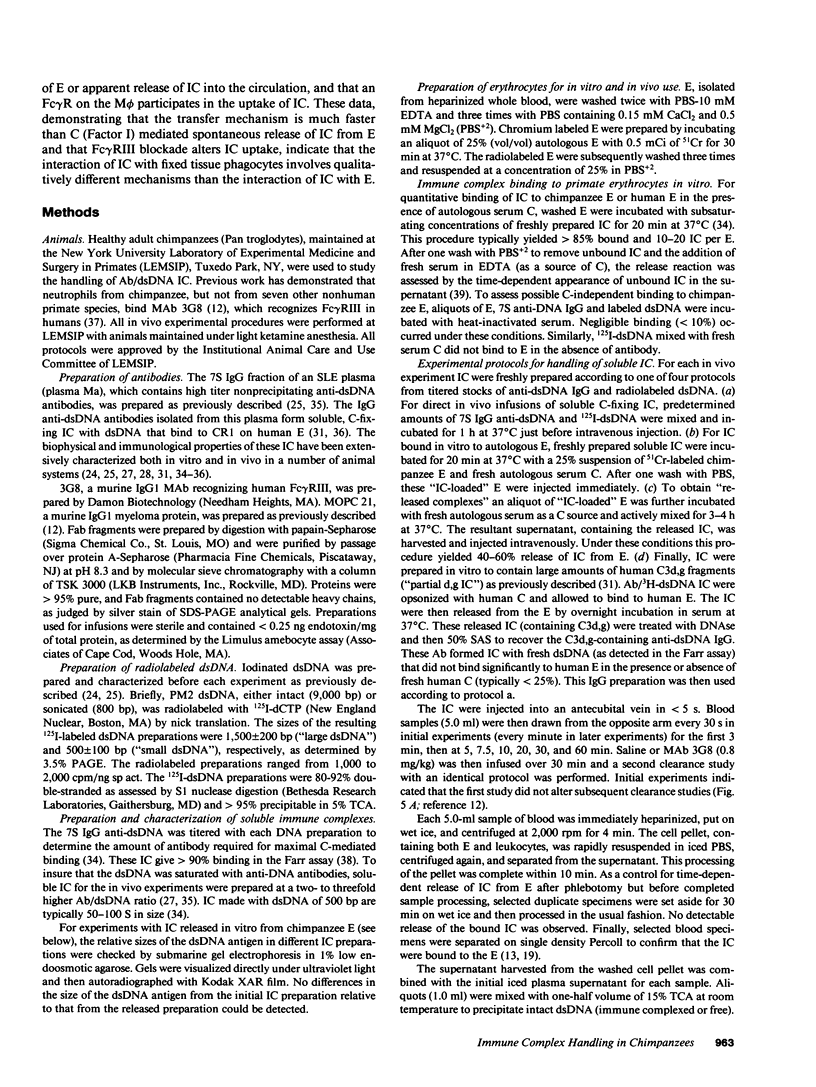
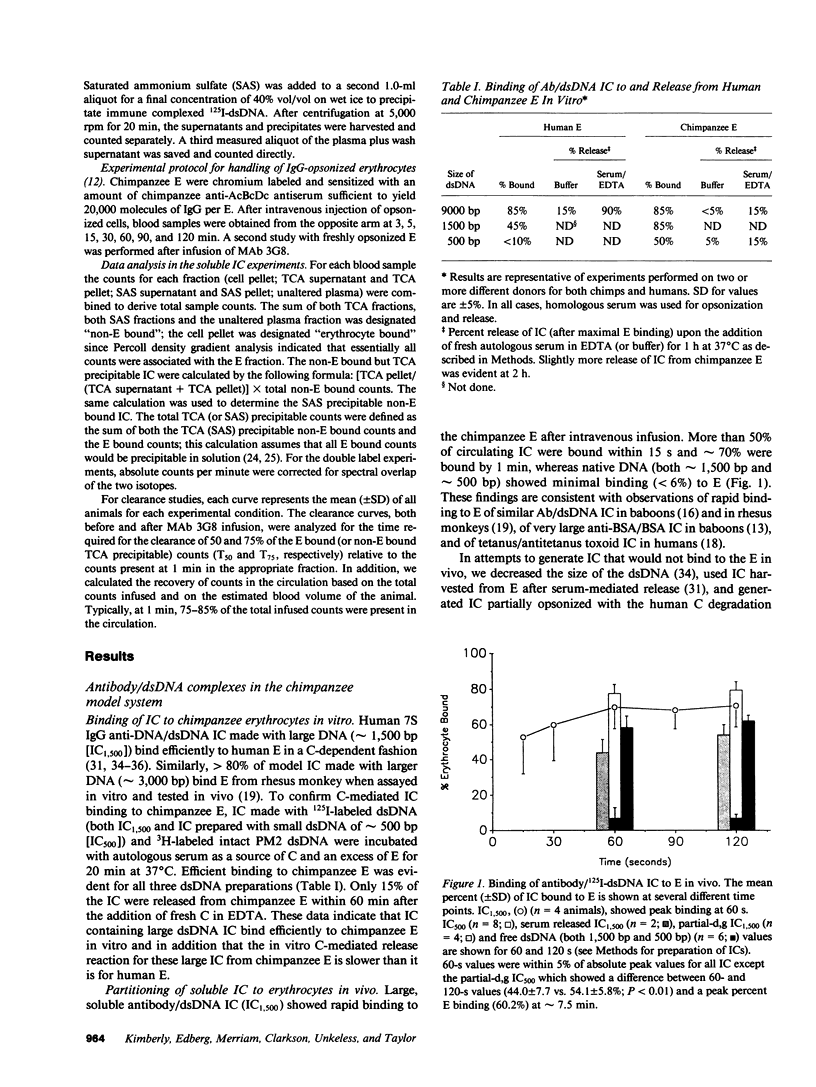
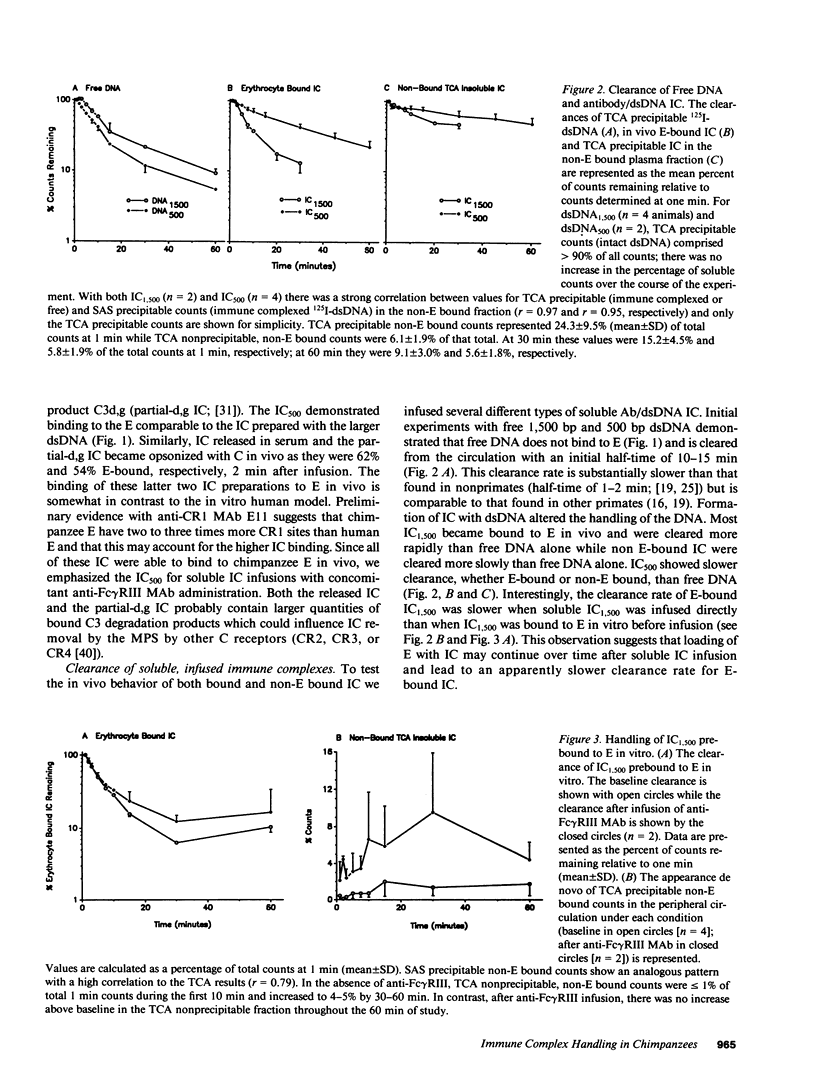

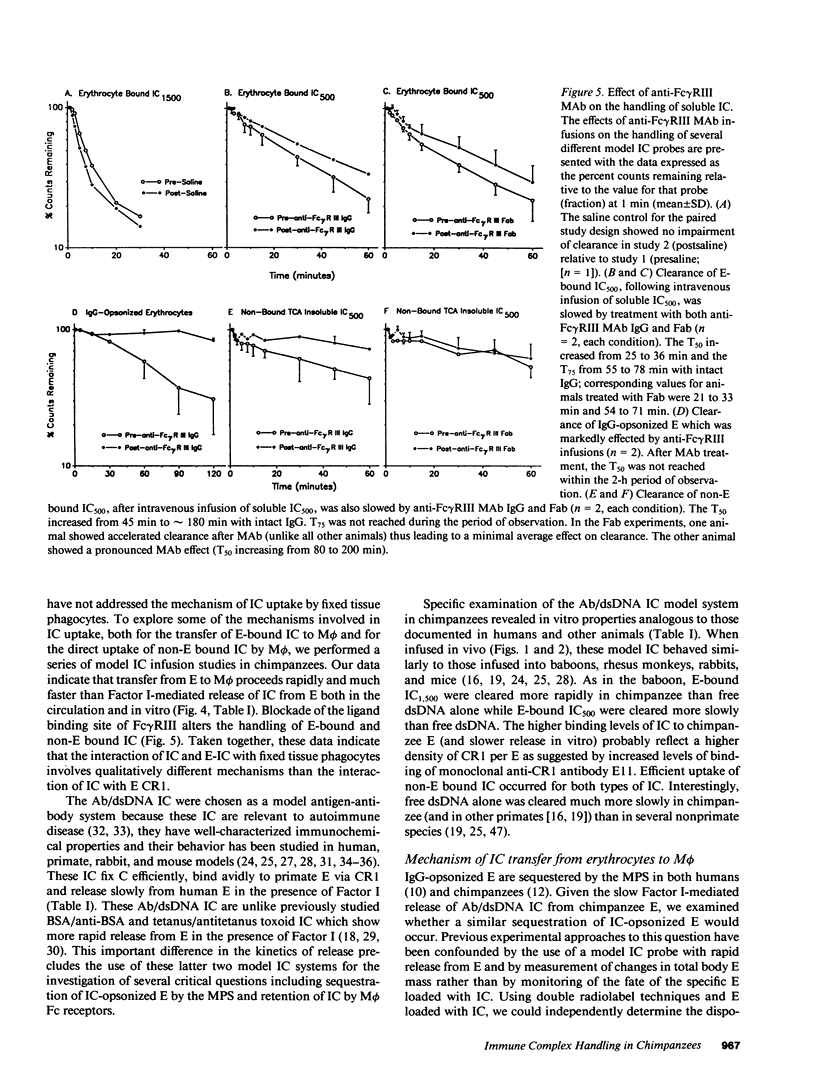
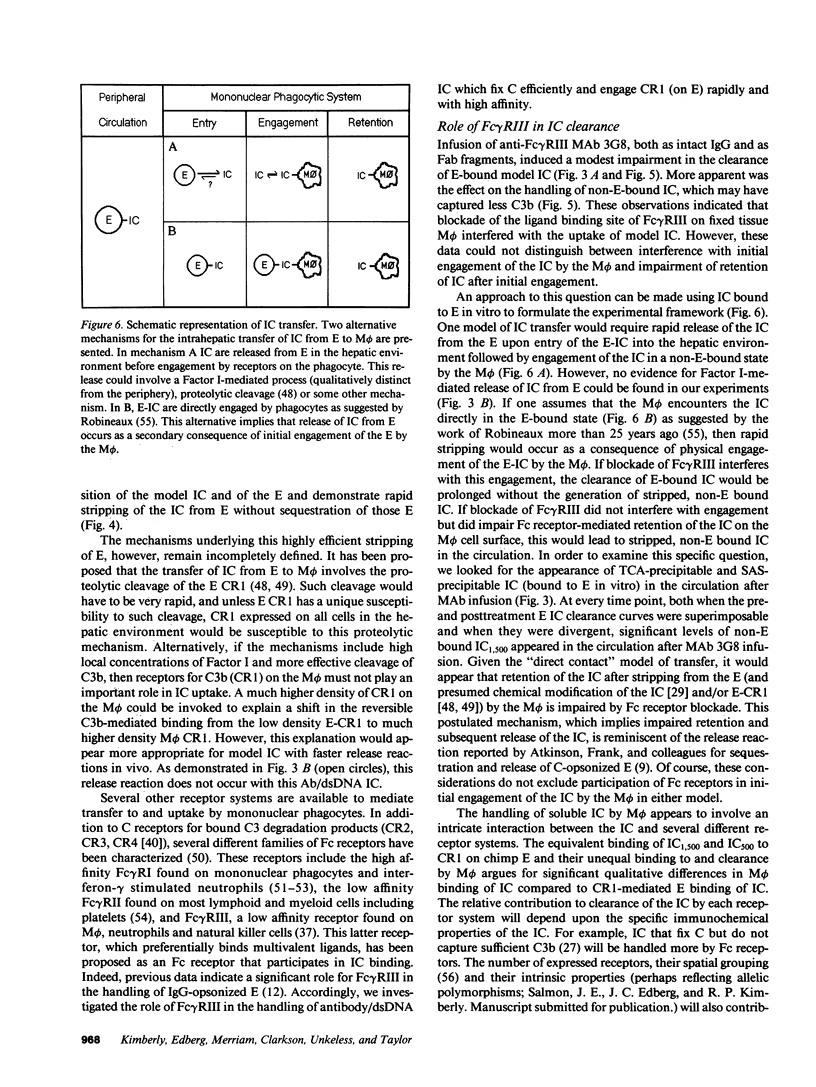
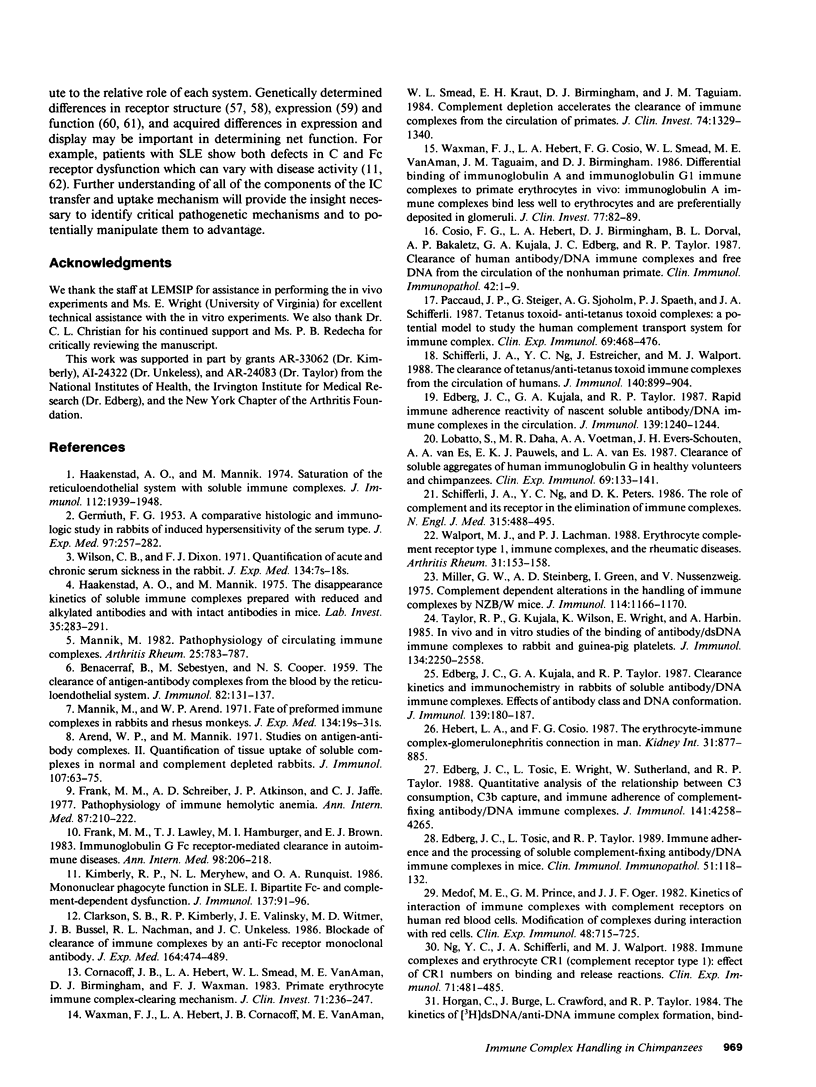
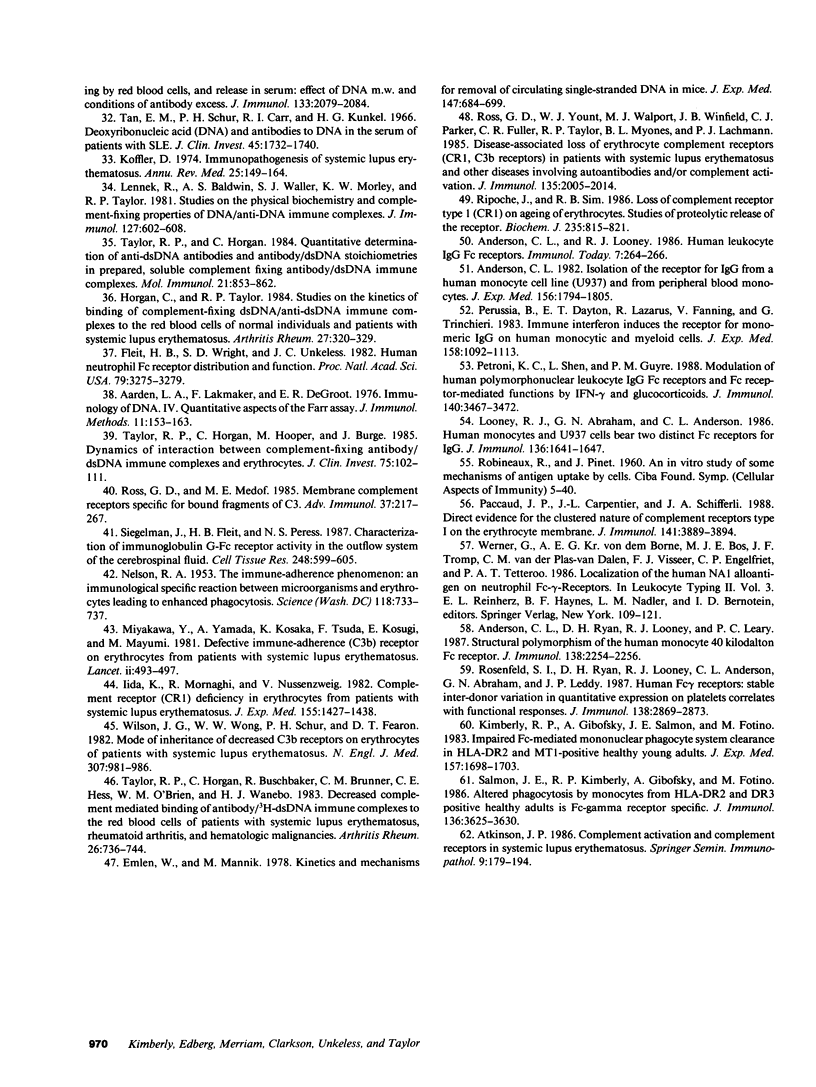
Selected References
These references are in PubMed. This may not be the complete list of references from this article.
- Aarden L. A., Lakmaker F., De Groot E. R. Immunology of DNA. IV. Quantitative aspects of the Farr assay. J Immunol Methods. 1976;11(2):153–163. doi: 10.1016/0022-1759(76)90143-5. [DOI] [PubMed] [Google Scholar]
- Anderson C. L. Isolation of the receptor for IgG from a human monocyte cell line (U937) and from human peripheral blood monocytes. J Exp Med. 1982 Dec 1;156(6):1794–1806. doi: 10.1084/jem.156.6.1794. [DOI] [PMC free article] [PubMed] [Google Scholar]
- Anderson C. L., Ryan D. H., Looney R. J., Leary P. C. Structural polymorphism of the human monocyte 40 kilodalton Fc receptor for IgG. J Immunol. 1987 Apr 1;138(7):2254–2256. [PubMed] [Google Scholar]
- Arend W. P., Mannik M. Studies on antigen-antibody complexes. II. Quantification of tissue uptake of soluble complexes in normal and complement-depleted rabbits. J Immunol. 1971 Jul;107(1):63–75. [PubMed] [Google Scholar]
- Atkinson J. P. Complement activation and complement receptors in systemic lupus erythematosus. Springer Semin Immunopathol. 1986;9(2-3):179–194. doi: 10.1007/BF02099021. [DOI] [PubMed] [Google Scholar]
- BENACERRAF B., SEBESTYEN M., COOPER N. S. The clearance of antigen antibody complexes from the blood by the reticuloendothelial system. J Immunol. 1959 Feb;82(2):131–137. [PubMed] [Google Scholar]
- Clarkson S. B., Kimberly R. P., Valinsky J. E., Witmer M. D., Bussel J. B., Nachman R. L., Unkeless J. C. Blockade of clearance of immune complexes by an anti-Fc gamma receptor monoclonal antibody. J Exp Med. 1986 Aug 1;164(2):474–489. doi: 10.1084/jem.164.2.474. [DOI] [PMC free article] [PubMed] [Google Scholar]
- Cornacoff J. B., Hebert L. A., Smead W. L., VanAman M. E., Birmingham D. J., Waxman F. J. Primate erythrocyte-immune complex-clearing mechanism. J Clin Invest. 1983 Feb;71(2):236–247. doi: 10.1172/JCI110764. [DOI] [PMC free article] [PubMed] [Google Scholar]
- Cosio F. G., Hebert L. A., Birmingham D. J., Dorval B. L., Bakaletz A. P., Kujala G. A., Edberg J. C., Taylor R. P. Clearance of human antibody/DNA immune complexes and free DNA from the circulation of the nonhuman primate. Clin Immunol Immunopathol. 1987 Jan;42(1):1–9. doi: 10.1016/0090-1229(87)90167-x. [DOI] [PubMed] [Google Scholar]
- Edberg J. C., Kujala G. A., Taylor R. P. Clearance kinetics and immunochemistry in rabbits of soluble antibody/DNA immune complexes. Effects of antibody class and DNA conformation. J Immunol. 1987 Jul 1;139(1):180–187. [PubMed] [Google Scholar]
- Edberg J. C., Kujala G. A., Taylor R. P. Rapid immune adherence reactivity of nascent, soluble antibody/DNA immune complexes in the circulation. J Immunol. 1987 Aug 15;139(4):1240–1244. [PubMed] [Google Scholar]
- Edberg J. C., Tosic L., Taylor R. P. Immune adherence and the processing of soluble complement-fixing antibody/DNA immune complexes in mice. Clin Immunol Immunopathol. 1989 Apr;51(1):118–132. doi: 10.1016/0090-1229(89)90212-2. [DOI] [PubMed] [Google Scholar]
- Edberg J. C., Tosic L., Wright E. L., Sutherland W. M., Taylor R. P. Quantitative analyses of the relationship between C3 consumption, C3b capture, and immune adherence of complement-fixing antibody/DNA immune complexes. J Immunol. 1988 Dec 15;141(12):4258–4265. [PubMed] [Google Scholar]
- Emlen W., Mannik M. Kinetics and mechanisms for removal of circulating single-stranded DNA in mice. J Exp Med. 1978 Mar 1;147(3):684–699. doi: 10.1084/jem.147.3.684. [DOI] [PMC free article] [PubMed] [Google Scholar]
- Fleit H. B., Wright S. D., Unkeless J. C. Human neutrophil Fc gamma receptor distribution and structure. Proc Natl Acad Sci U S A. 1982 May;79(10):3275–3279. doi: 10.1073/pnas.79.10.3275. [DOI] [PMC free article] [PubMed] [Google Scholar]
- Frank M. M., Lawley T. J., Hamburger M. I., Brown E. J. NIH Conference: Immunoglobulin G Fc receptor-mediated clearance in autoimmune diseases. Ann Intern Med. 1983 Feb;98(2):206–218. doi: 10.7326/0003-4819-98-2-218. [DOI] [PubMed] [Google Scholar]
- GERMUTH F. G., Jr A comparative histologic and immunologic study in rabbits of induced hypersensitivity of the serum sickness type. J Exp Med. 1953 Feb 1;97(2):257–282. doi: 10.1084/jem.97.2.257. [DOI] [PMC free article] [PubMed] [Google Scholar]
- Haakenstad A. O., Mannik M. Saturation of the reticuloendothelial system with soluble immune complexes. J Immunol. 1974 May;112(5):1939–1948. [PubMed] [Google Scholar]
- Haakenstad A. O., Mannik M. The disappearance kinetics of soluble immune complexes prepared with reduced and alkylated antibodies and with intact antibodies in mice. Lab Invest. 1976 Sep;35(3):283–292. [PubMed] [Google Scholar]
- Hebert L. A., Cosio G. The erythrocyte-immune complex-glomerulonephritis connection in man. Kidney Int. 1987 Apr;31(4):877–885. doi: 10.1038/ki.1987.81. [DOI] [PubMed] [Google Scholar]
- Horgan C., Burge J., Crawford L., Taylor R. P. The kinetics of [3H]-dsDNA/anti-DNA immune complex formation, binding by red blood cells, and release into serum: effect of DNA molecular weight and conditions of antibody excess. J Immunol. 1984 Oct;133(4):2079–2084. [PubMed] [Google Scholar]
- Horgan C., Taylor R. P. Studies on the kinetics of binding of complement-fixing dsDNA/anti-dsDNA immune complexes to the red blood cells of normal individuals and patients with systemic lupus erythematosus. Arthritis Rheum. 1984 Mar;27(3):320–329. doi: 10.1002/art.1780270312. [DOI] [PubMed] [Google Scholar]
- Iida K., Mornaghi R., Nussenzweig V. Complement receptor (CR1) deficiency in erythrocytes from patients with systemic lupus erythematosus. J Exp Med. 1982 May 1;155(5):1427–1438. doi: 10.1084/jem.155.5.1427. [DOI] [PMC free article] [PubMed] [Google Scholar]
- Kimberly R. P., Gibofsky A., Salmon J. E., Fotino M. Impaired fc-mediated mononuclear phagocyte system clearance in HLA-DR2 and MT1-positive healthy young adults. J Exp Med. 1983 May 1;157(5):1698–1703. doi: 10.1084/jem.157.5.1698. [DOI] [PMC free article] [PubMed] [Google Scholar]
- Kimberly R. P., Meryhew N. L., Runquist O. A. Mononuclear phagocyte function in SLE. I. Bipartite Fc- and complement-dependent dysfunction. J Immunol. 1986 Jul 1;137(1):91–96. [PubMed] [Google Scholar]
- Koffler D. Immunopathogenesis of systemic lupus erythematosus. Annu Rev Med. 1974;25:149–164. doi: 10.1146/annurev.me.25.020174.001053. [DOI] [PubMed] [Google Scholar]
- Lennek R., Baldwin A. S., Jr, Waller S. J., Morley K. W., Taylor R. P. Studies of the physical biochemistry and complement-fixing properties of DNA/anti-DNA immune complexes. J Immunol. 1981 Aug;127(2):602–608. [PubMed] [Google Scholar]
- Lobatto S., Daha M. R., Voetman A. A., Evers-Schouten J. H., Van Es A. A., Pauwels E. K., Van Es L. A. Clearance of soluble aggregates of human immunoglobulin G in healthy volunteers and chimpanzees. Clin Exp Immunol. 1987 Jul;69(1):133–141. [PMC free article] [PubMed] [Google Scholar]
- Looney R. J., Abraham G. N., Anderson C. L. Human monocytes and U937 cells bear two distinct Fc receptors for IgG. J Immunol. 1986 Mar 1;136(5):1641–1647. [PubMed] [Google Scholar]
- Mannik M. Pathophysiology of circulating immune complexes. Arthritis Rheum. 1982 Jul;25(7):783–787. doi: 10.1002/art.1780250713. [DOI] [PubMed] [Google Scholar]
- Medof M. E., Prince G. M., Oger J. J. Kinetics of interaction of immune complexes with complement receptors on human blood cells: modification of complexes during interaction with red cells. Clin Exp Immunol. 1982 Jun;48(3):715–725. [PMC free article] [PubMed] [Google Scholar]
- Miller G. W., Steinberg A. D., Green I., Nussenzweig V. Complement-dependent alterations in the handling of immune complexes by NZB/W mice. J Immunol. 1975 Apr;114(4):1166–1170. [PubMed] [Google Scholar]
- Miyakawa Y., Yamada A., Kosaka K., Tsuda F., Kosugi E., Mayumi M. Defective immune-adherence (C3b) receptor on erythrocytes from patients with systemic lupus erythematosus. Lancet. 1981 Sep 5;2(8245):493–497. doi: 10.1016/s0140-6736(81)90882-5. [DOI] [PubMed] [Google Scholar]
- NELSON R. A., Jr The immune-adherence phenomenon; an immunologically specific reaction between microorganisms and erythrocytes leading to enhanced phagocytosis. Science. 1953 Dec 18;118(3077):733–737. doi: 10.1126/science.118.3077.733. [DOI] [PubMed] [Google Scholar]
- NIH conference. Pathophysiology of immune hemolytic anemia. Ann Intern Med. 1977 Aug;87(2):210–222. doi: 10.7326/0003-4819-87-2-210. [DOI] [PubMed] [Google Scholar]
- Ng Y. C., Schifferli J. A., Walport M. J. Immune complexes and erythrocyte CR1 (complement receptor type 1): effect of CR1 numbers on binding and release reactions. Clin Exp Immunol. 1988 Mar;71(3):481–485. [PMC free article] [PubMed] [Google Scholar]
- Paccaud J. P., Carpentier J. L., Schifferli J. A. Direct evidence for the clustered nature of complement receptors type 1 on the erythrocyte membrane. J Immunol. 1988 Dec 1;141(11):3889–3894. [PubMed] [Google Scholar]
- Paccaud J. P., Steiger G., Sjöholm A. G., Spaeth P. J., Schifferli J. A. Tetanus toxoid-anti-tetanus toxoid complexes: a potential model to study the complement transport system for immune complex in humans. Clin Exp Immunol. 1987 Aug;69(2):468–476. [PMC free article] [PubMed] [Google Scholar]
- Perussia B., Dayton E. T., Lazarus R., Fanning V., Trinchieri G. Immune interferon induces the receptor for monomeric IgG1 on human monocytic and myeloid cells. J Exp Med. 1983 Oct 1;158(4):1092–1113. doi: 10.1084/jem.158.4.1092. [DOI] [PMC free article] [PubMed] [Google Scholar]
- Petroni K. C., Shen L., Guyre P. M. Modulation of human polymorphonuclear leukocyte IgG Fc receptors and Fc receptor-mediated functions by IFN-gamma and glucocorticoids. J Immunol. 1988 May 15;140(10):3467–3472. [PubMed] [Google Scholar]
- Ripoche J., Sim R. B. Loss of complement receptor type 1 (CR1) on ageing of erythrocytes. Studies of proteolytic release of the receptor. Biochem J. 1986 May 1;235(3):815–821. doi: 10.1042/bj2350815. [DOI] [PMC free article] [PubMed] [Google Scholar]
- Rosenfeld S. I., Ryan D. H., Looney R. J., Anderson C. L., Abraham G. N., Leddy J. P. Human Fc gamma receptors: stable inter-donor variation in quantitative expression on platelets correlates with functional responses. J Immunol. 1987 May 1;138(9):2869–2873. [PubMed] [Google Scholar]
- Ross G. D., Medof M. E. Membrane complement receptors specific for bound fragments of C3. Adv Immunol. 1985;37:217–267. doi: 10.1016/s0065-2776(08)60341-7. [DOI] [PubMed] [Google Scholar]
- Ross G. D., Yount W. J., Walport M. J., Winfield J. B., Parker C. J., Fuller C. R., Taylor R. P., Myones B. L., Lachmann P. J. Disease-associated loss of erythrocyte complement receptors (CR1, C3b receptors) in patients with systemic lupus erythematosus and other diseases involving autoantibodies and/or complement activation. J Immunol. 1985 Sep;135(3):2005–2014. [PubMed] [Google Scholar]
- Salmon J. E., Kimberly R. P., Gibofsky A., Fotino M. Altered phagocytosis by monocytes from HLA-DR2 and DR3-positive healthy adults is Fc gamma receptor specific. J Immunol. 1986 May 15;136(10):3625–3630. [PubMed] [Google Scholar]
- Schifferli J. A., Ng Y. C., Estreicher J., Walport M. J. The clearance of tetanus toxoid/anti-tetanus toxoid immune complexes from the circulation of humans. Complement- and erythrocyte complement receptor 1-dependent mechanisms. J Immunol. 1988 Feb 1;140(3):899–904. [PubMed] [Google Scholar]
- Schifferli J. A., Ng Y. C., Peters D. K. The role of complement and its receptor in the elimination of immune complexes. N Engl J Med. 1986 Aug 21;315(8):488–495. doi: 10.1056/NEJM198608213150805. [DOI] [PubMed] [Google Scholar]
- Siegelman J., Fleit H. B., Peress N. S. Characterization of immunoglobulin G-Fc receptor activity in the outflow system of the cerebrospinal fluid. Cell Tissue Res. 1987 Jun;248(3):599–605. doi: 10.1007/BF00216489. [DOI] [PubMed] [Google Scholar]
- Tan E. M., Schur P. H., Carr R. I., Kunkel H. G. Deoxybonucleic acid (DNA) and antibodies to DNA in the serum of patients with systemic lupus erythematosus. J Clin Invest. 1966 Nov;45(11):1732–1740. doi: 10.1172/JCI105479. [DOI] [PMC free article] [PubMed] [Google Scholar]
- Taylor R. P., Horgan C., Buschbacher R., Brunner C. M., Hess C. E., O'Brien W. M., Wanebo H. J. Decreased complement mediated binding of antibody/3H-dsDNA immune complexes to the red blood cells of patients with systemic lupus erythematosus, rheumatoid arthritis, and hematologic malignancies. Arthritis Rheum. 1983 Jun;26(6):736–744. doi: 10.1002/art.1780260606. [DOI] [PubMed] [Google Scholar]
- Taylor R. P., Horgan C., Hooper M., Burge J. Dynamics of interaction between complement-fixing antibody/dsDNA immune complexes and erythrocytes. In vitro studies and potential general applications to clinical immune complex testing. J Clin Invest. 1985 Jan;75(1):102–111. doi: 10.1172/JCI111660. [DOI] [PMC free article] [PubMed] [Google Scholar]
- Taylor R. P., Horgan C. Quantitative determination of anti-dsDNA antibodies and antibody/dsDNA stoichiometries in prepared, soluble complement-fixing antibody/dsDNA immune complexes. Mol Immunol. 1984 Oct;21(10):853–862. doi: 10.1016/0161-5890(84)90139-1. [DOI] [PubMed] [Google Scholar]
- Taylor R. P., Kujala G., Wilson K., Wright E., Harbin A. In vivo and in vitro studies of the binding of antibody/dsDNA immune complexes to rabbit and guinea pig platelets. J Immunol. 1985 Apr;134(4):2550–2558. [PubMed] [Google Scholar]
- Walport M. J., Lachmann P. J. Erythrocyte complement receptor type 1, immune complexes, and the rheumatic diseases. Arthritis Rheum. 1988 Feb;31(2):153–158. doi: 10.1002/art.1780310201. [DOI] [PubMed] [Google Scholar]
- Waxman F. J., Hebert L. A., Cornacoff J. B., VanAman M. E., Smead W. L., Kraut E. H., Birmingham D. J., Taguiam J. M. Complement depletion accelerates the clearance of immune complexes from the circulation of primates. J Clin Invest. 1984 Oct;74(4):1329–1340. doi: 10.1172/JCI111543. [DOI] [PMC free article] [PubMed] [Google Scholar]
- Waxman F. J., Hebert L. A., Cosio F. G., Smead W. L., VanAman M. E., Taguiam J. M., Birmingham D. J. Differential binding of immunoglobulin A and immunoglobulin G1 immune complexes to primate erythrocytes in vivo. Immunoglobulin A immune complexes bind less well to erythrocytes and are preferentially deposited in glomeruli. J Clin Invest. 1986 Jan;77(1):82–89. doi: 10.1172/JCI112306. [DOI] [PMC free article] [PubMed] [Google Scholar]
- Wilson J. G., Wong W. W., Schur P. H., Fearon D. T. Mode of inheritance of decreased C3b receptors on erythrocytes of patients with systemic lupus erythematosus. N Engl J Med. 1982 Oct 14;307(16):981–986. doi: 10.1056/NEJM198210143071604. [DOI] [PubMed] [Google Scholar]


